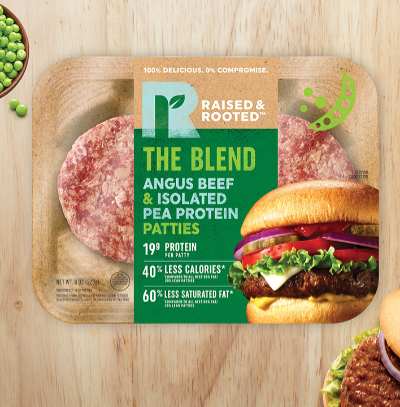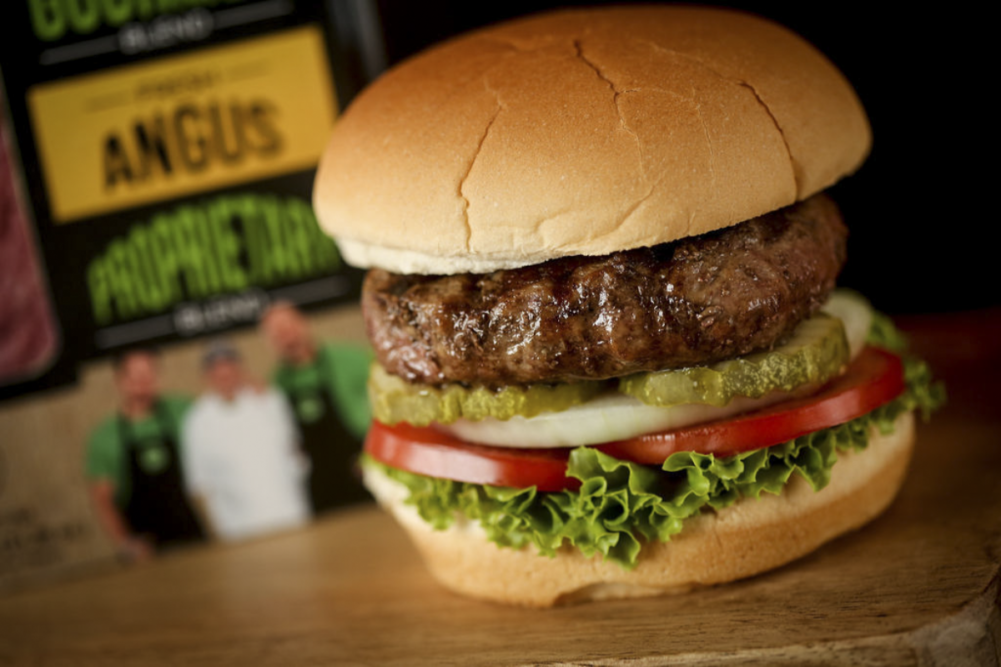Grocerant concepts and foodservice offerings within the supermarket are redefining burgers and lighting a flame under the market.
Infinitely customizable, burgers are one of the most quintessential of foods. The simple hamburger patty can please the picky eaters (a plain burger, please) and be a springboard for innovation and creativity. Enjoyed at home and out, 42% of those surveyed by Technomic say they have a preferred restaurant to eat a burger.
But new influences are creating challenges around the burger category. Rising labor and delivery costs associated with a growing preference for off-premise dining add to the cost of dining out, and for some consumers these changes make enjoying burgers in a restaurant less economically feasible.
In order to rejuvenate interest and justify needed price increases, a growing number of burger retailers are enlisting the appeal of the limited time offer (LTO). This might include seasonal specials, themed burgers, adding a unique topping to a burger patty or substituting doughnuts or ramen for a bakery bun.
Twenty-four percent of those surveyed expressed interest in trying burgers with unusual buns. Breakfast burgers offer alternative buns in the form of pancakes, waffles, hash browns or tortillas and additions of eggs and bacon on top make for good value-adds. Innovative LTO offerings play into feelings of FOMO (fear of missing out) that strongly resonate with younger consumers.
With restaurant dining on the decline, especially among Millennials and Gen Y, supermarkets are seeing new opportunities to showcase fresh ingredients in a supermarket-based foodservice option. The grocerant concept offers the promise of a delicious on-premise dining experience and can make the chore of grocery shopping more appealing for all consumers. Grocerants also accommodate the preferences of Millennials who view grocery-prepared foods as being fresher.
“Consumers want products that are more exciting or that put a new spin on a traditional product,” says Stephanie Carlson, global marketing manager, meat industry, Corbion, Lenexa, Kansas. “These types of foods signal to customers that the ingredients used are of a higher quality or that the product offers a higher degree of value. Often, consumers perceive the presence of more premium ingredients as being associated with a healthier product.”
Planned Destination
Fast, fresh and casual, the grocerant concept presents consumers with offerings both predictable and ever-changing. This includes evolutions in layout as stores shrink the inner aisles to make more room for in-store dining. Shoppers who come for the basics are likely to stumble upon options for freshly ground and grilled burgers and an invitation to enjoy craft beer or wine as they sip and stroll around the store.
Through exploration of the perimeter, consumers are discovering an ever-expanding selection of prepared foods, meats and cheeses, fresh baked breads and the convenience of meats ground fresh by an in-house butcher, resulting in increased foot traffic and time spent on premises.
“What’s great about burgers is that they can open consumer’s eyes to products that they might not have considered like a cheese they’ve never tried before,” says Eric Richard, education coordinator of the Madison, Wisconsin-based International Dairy Deli Bakery Association (IDDBA). “Introduction to something new can help boost engagement and awareness, possibly leading that individual to check out the cheese in the deli department.”
Knowing the appe al of a freshly made burger, many supermarkets are anchoring a signature food hall or in-house dining experience with a burger restaurant. Cincinnati-based Kroger’s On the Rhine Eatery offers freshly prepared burgers at Queen City Whip, part of Kroger’s five-restaurant, two-story Cincinnati-based concept.
al of a freshly made burger, many supermarkets are anchoring a signature food hall or in-house dining experience with a burger restaurant. Cincinnati-based Kroger’s On the Rhine Eatery offers freshly prepared burgers at Queen City Whip, part of Kroger’s five-restaurant, two-story Cincinnati-based concept.
Queen City Whip attracts diners with made-to-order burgers, chili dogs and milkshakes. Mariano’s Fresh Market, also owned by Kroger, offers customers the option to grill their meat or seafood purchase free of charge at Mariano’s locations throughout the Midwest. Consumers can choose to eat their freshly grilled item in the store, paired with a selection from the deli, or take it home.
Price Chopper’s Market Bistro includes branded food service stations including Custom Burgers. As a concept store, Market Bistro, Schenectady, New York, incorporates its innovations into other Market 32 and Price Chopper locations. With multiple venues, Wegman’s, Buffalo, New York, profiles the use of Wegman’s best ingredients into its Burger Bar concept. Menu items are available in store and some locations also offer online ordering.
Hy-Vee’s Market Grille concept offers consumers burgers featuring 100% natural Hy-Vee Choice Reserve Beef, a fresh bun from the bakery and fresh toppings. In some Market Grille locations, the West Des Moines, Iowa-based supermarket chain also offers Wahlburgers menu items, featuring the restaurant chain’s custom burger blend of Angus brisket, chuck and short rib. Wahlburgers offers a frozen version of some of the Walhburg brother’s favorite hamburgers in Hy-Vee’s frozen food aisle.
Blended Trends
In 2020, burger options include more than meat-based proteins. “Blended, less beefy burgers” made the list of the top food trends as predicted by Austin, Texas-based Whole Foods Market, and enthusiasm for plant-based offerings show no signs of slowing. But Mintel analysts predict plant-based offerings will minimize vegan attributes, instead playing up the nutritional aspects of plants in general. The analysts also forecast any claims made, regardless of the product, will be heavily scrutinized by consumers.
With this mindset, consumers will continue to expect the best of both worlds, choosing to consume both animal- and plant-based protein products. Younger consumers are no exception, expecting establishments to have at least one plant-based burger option on the menu, according to Technomic.
“The average consumer wants to try new products and that includes more veggies,” Richard says. “The flavors and textures of plant-based items are very similar to animal proteins and it’s important to have a plant-based option for those who identify as vegans and vegetarians along with the continuing evolution of flexitarian consumers.”
While plant-based proteins often have different, sometimes negative, perceptions of taste, there is also a feeling among consumers that the consumption of plants is better for the environment. Eating a plant-based option can fulfill consumer aspirations for better health through a purchase decision believed to be more ethical. Yet, those who choose plants don’t necessarily want to give up meat altogether.
Enter the Flexitarian
Midan Marketing, which has offices in Chicago and Mooresville, North Carolina, further expanded on the flexitarian concept in its Meat Consumer Segmentation 2.0 Report, released in 2019. Findings highlighted the changing environment of mainstream protein claims, including the rise of flexitarian consumers who represent one-fifth of meat eaters.
Described as Protein Progressives by Midan Marketing, this group is open to experimenting with different kinds of protein, but say they enjoy all forms of meat and are open to eating plant-based protein alternatives. Flexitarians along with grass-fed and plant-based meat eaters are the consumer groups making the biggest ripples in the meat industry, according to the report.

These groups are the intended audience for the growing range of blended burgers that feature mushrooms, grains and plant-based proteins. The New York-based James Beard Foundation has promoted The Blended Burger Project for the last four years. Striving to make burgers “better for customers and for the planet,” the Blended Burger contains at least 25% fresh mushrooms.
At Whole Foods, the Lika Plus burger, a combination of wheat, mushroom, barley yeast and water, is showing up at the meat counter with burgers featuring a 75% beef/25% Lika Plus blend. The Raised and Rooted brand of blend burgers from Tyson, Springdale, Arkansas, features Angus beef and pea protein.
Looking to find a middle ground between meat eaters and vegetarians, Applegate, owned by Hormel Food, Austin, Minnesota, makes Blend Burgers with 30% plant-based ingredients. The turkey and beef burgers contain part meat, part organic mushrooms and are Non-GMO Project certified and Whole 30 approved. Hormel also offers its foodservice customers the Fuse burger, which combines lean protein with whole grains, veggies and fruit.
“I believe you’ll see more flavor varieties enter the plant-based burger arena,” says Andrew Quinn, senior brand manager, Hormel Deli Solutions, Hormel Foods, Austin, Minnesota. “Interweaving flavor trends with a shift toward plant-based proteins seems like a natural next shift.”
Corbion acknowledges that innovative and effective technologies will be necessary for plant-based proteins and controlling spoilage and pathogens will remain an important facet of working with these products.
“No matter if the product is meat or plant-based, consumers hold their food items to rigorous standards of quality, texture and taste when they evaluate products,” Carlson says.
Whether you rest firmly in the pro-meat category or welcome new takes on plant-based options incorporating grains, vegetables and mushrooms, burgers are an appealing and evergreen concept. Using the freshest ingredients and the ability to draw inspiration from trends, supermarkets are the perfect playground and proving ground for the burger station concept.
“The image of the supermarket as a destination for prepared food comes down to delivering a superior product,” Richard says. “If a retailer wants to compete, they must create a robust and successful program that focuses on freshness and taste.”

